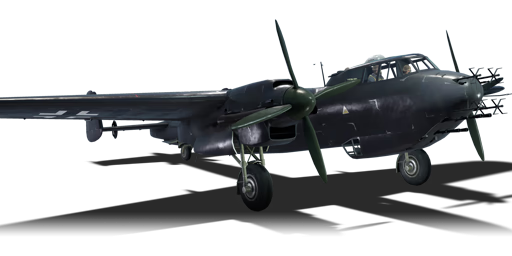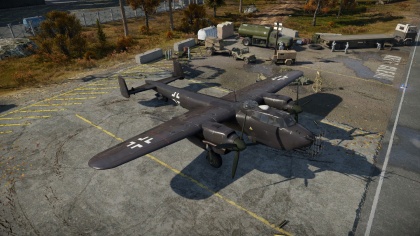Do 217 N-1
Contents
| This page is about the German twin-engine fighter Do 217 N-1. For other uses, see Do 217 (Family). |
Description
The Do 217 N-1 is a rank II German twin-engine fighter
with a battle rating of 3.0 (AB), 2.3 (RB), and 3.3 (SB). This twin-engine fighter was introduced in Update 1.29.
The Do 217 N-1 is a classic heavy fighter with tremendous firepower, but poor flight performance.
The Do 217 N-1 is a twin-engine fighter that can function as a ground attack aircraft (strafing enemy ground targets and/or using the bombs that it can carry) or be used as an interceptor (interceptor aircraft are planes that are used for anti-bomber roles).
General info
Flight Performance
Describe how the aircraft behaves in the air. Speed, manoeuvrability, acceleration and allowable loads - these are the most important characteristics of the vehicle.
| Characteristics | |||||||
|---|---|---|---|---|---|---|---|
| Stock | |||||||
| Max Speed (km/h at 5,500 m) |
Max altitude (meters) |
Turn time (seconds) |
Rate of climb (meters/second) |
Take-off run (meters) | |||
| AB | RB | AB | RB | AB | RB | ||
| 495 | 477 | 9000 | 28.9 | 30.2 | 4.7 | 4.6 | 800 |
| Upgraded | |||||||
| Max Speed (km/h at 5,500 m) |
Max altitude (meters) |
Turn time (seconds) |
Rate of climb (meters/second) |
Take-off run (meters) | |||
| AB | RB | AB | RB | AB | RB | ||
| 539 | 515 | 9000 | 26.4 | 27.7 | 9.3 | 6.8 | 800 |
Details
| Features | ||||
|---|---|---|---|---|
| Combat flaps | Take-off flaps | Landing flaps | Air brakes | Arrestor gear |
| X | ✓ | ✓ | X | X |
| Limits | ||||
|---|---|---|---|---|
| Wing-break speed (km/h) |
Gear limit (km/h) |
Combat flaps (km/h) |
Max Static G | |
| + | - | |||
| N/A | ~6 | ~5 | ||
| Optimal velocities | |||
|---|---|---|---|
| Ailerons (km/h) |
Rudder (km/h) |
Elevators (km/h) |
Radiator (km/h) |
| < 290 | < 360 | < 360 | > 315 |
| Compressor (RB/SB) | ||
|---|---|---|
| Setting 1 | ||
| Optimal altitude | 100% Engine power | WEP Engine power |
| 1,000 m | 1,460 hp | 1,522 hp |
| Setting 2 | ||
| Optimal altitude | 100% Engine power | WEP Engine power |
| 4,850 m | 1,300 hp | 1,355 hp |
Survivability and armour
- 8.5 mm Steel - Fore-cockpit plate
- 8.5 mm Steel - Pilot's seat
- 50 mm Bulletproof Glass
- 8.5 mm Steel - Dorsal gunner's plate
- 5 mm Steel - Belly gunner's plate
- 8.5 mm Steel - Belly gunner's upper plate
- 5 mm Steel - Engine armor plate x 2
- 5 mm Steel - Aft plate
Armaments
Offensive armament
The Do 217 N-1 is armed with:
- 4 x 20 mm MG 151/20 cannons, chin-mounted (200 rpg = 800 total)
- 4 x 7.92 mm MG 17 machine guns, nose-mounted (1,000 rpg = 4,000 total)
Suspended armament
The Do 217 N-1 can be outfitted with the following ordnance:
- Without load
- 8 x 50 kg SC50JA bombs (400 kg total)
Defensive armament
The Do 217 N-1 is defended by:
- 1 x 13 mm MG 131 machine gun, dorsal turret (500 rpg)
- 1 x 13 mm MG 131 machine gun, ventral turret (1,000 rpg)
Usage in battles
The Do 217 N-1 is yet another "zerstörer" heavy fighter in the German tech tree. It is functionally a Do 217 J-2 with the MG FF/M cannons having been replaced with the faster firing, high velocity 20 mm MG 151/20 cannons. With that being said however, it has the exact same strengths and weaknesses as the J-2. That's to say it has an amazing armament for its battle rating, but lacks the manoeuvrability and speed to use it effectively, especially in a dogfight.
The Do 217 N-1 should be treated like an even more polarised version of the Bf 110 C-7, with an even bigger commitment to Boom and Zoom tactics since it has very poor manoeuvrability. That means keeping a significant altitude superiority over your enemies is paramount to success, in order to dive on them and destroy them in a single pass before using the speed to climb back up to altitude where any potential enemies hopefully won't be able to follow you. Keep in mind however that the Do 217 N-1's battle rating is at 4.0 meaning you may be pitted against faster fighters (like the P-47 or the P-39Q) that can catch up to you if they dive on you during a zoom climb, if they have an altitude advantage.
Against a Do 217 N-1, never go head-on with this plane because the heavy firepower of 4 x 20 mm MG 151/20 cannons and 4 x 7.92 mm MG 17 machine guns will shred any plane head on and it is very hard to pilot snipe this plane frontally as there is a lot of bulletproof glass and armour protecting the pilot. If you encounter a Do 217 N-1 attack it from above, behind or below the aircraft.
Radars
The Do 217 N-1 is equipped with a FuG 202 search radar, located in the nose of the aircraft; a control box which is part of the radar damage model is located behind the pilot.
| FuG 202 - Target Detection Radar | |||
|---|---|---|---|
| Maximum Detection Range |
Guaranteed Detection Range |
Max Azimuth Scan Angle |
Max Elevation Scan Angle |
| 4,000 m | 4,000 m | ±30° | ±30° |
Manual Engine Control
| MEC elements | ||||||
|---|---|---|---|---|---|---|
| Mixer | Pitch | Radiator | Supercharger | Turbocharger | ||
| Oil | Water | Type | ||||
| Not controllable | Controllable Not auto controlled |
Not controllable Not auto controlled |
Controllable Not auto controlled |
Combined | Not controllable 2 gears |
Not controllable |
Modules
| Tier | Flight performance | Survivability | Weaponry | ||
|---|---|---|---|---|---|
| I | Fuselage repair | Radiator | Offensive 7 mm | ||
| II | Compressor | Airframe | New 7 mm MGs | Turret 13 mm | |
| III | Wings repair | Engine | Offensive 20 mm | New 13 mm MGs (turret) | |
| IV | Engine injection | Cover | New 20 mm cannons | ||
Pros and cons
Pros:
- Very heavy armament which is all nose mounted
- Rigid construction that can take a lot of punishment from machine gun fire
- Decent defensive armament consisting of 2 x 13 mm MG 131 turrets, with a reasonable coverage
- Improved ballistic performance of the 20 mm MG 151 over the FF/M allows for firing both the machine guns and cannons at the same time and hit the target
- Very good at head-on attacks
- Has access to a target detection radar
Cons:
- Slow
- Poor climb rate
- Poor acceleration
- Poor manoeuvrability
- Poor energy retention
- Poor roll rate
- Its poor flight performance makes it thoroughly difficult to effectively combat other fighters
- Easily compresses surface controls at high speeds
History
The Dornier Do 217 is a multi-role aircraft (bomber, reconnaissance aircraft, night fighter) built for the Luftwaffe during World War 2. It is very similar to many previous Dornier built bombers like the Dornier Do 17 in its 'Flying Pencil' shape and fuselage. Overall 1,925 Dornier Do 217s were made as well as many variants. The Do 217 J and Do 217 N variants were mainly used as night fighters to deal with the RAF's nightly bombing raids. The rest of the variants would be used as bombers or reconnaissance aircraft depending on which mission they would be on.
In-game description
Dornier Do 217 N-1 night twin-engine fighter.
At the same time the Do 217M bomber was created, Dornier Flugzeugwerke also developed the Do 217N night fighter to enable the installation of DB 603A engines. The first prototype got off the ground in July 1942.
Production Do 217 N-1 night fighters were armed with 20 mm Mauser MG 151/20 cannons (belt-fed, with 200 rounds each), which had a high rate of fire and better ballistic characteristics, instead of 20 mm Oerlikon MG FF/M cannons.
Four additional 20 mm Mauser MG 151/20 cannons could be installed, inclined in a so-called Schräge Musik mount in the upper section of the aircraft. ""Schräge Musik"" literally means ""oblique (or weird) music"", which was a colloquial name for ""abnormal"" jazz in Germany of that period. The Schräge Musik mount was implemented via the removable R22 factory kit and included fuselage-mounted cannons that fired upward and forward at a 70-degree angle. Oberleutnant Rudolf Schoenert, an ace of night fighter aviation, had developed the idea.
The Schräge Musik mount allowed a night fighter to attack a bomber from below, that is at their belly, which was the least-protected area of the plane. Although the Schräge Musik mount increased the aircraft's takeoff weight, its combat effectiveness justified this disadvantage.
Since the plane's defensive armament was recognized as unnecessary for the night fighter, some planes had their upper turret removed and their lower gun position terminated. The projection for the lower turret was then removed with the help of a long wooden fairing. These modifications reduced the night fighter's weight and improved its aerodynamics. The planes that were modified in this way were designated Do 217 N-1/U1.
The standard package of the Do 217 N-1 included a FuG 202 Lichtenstein B/C airborne radar. In addition, the plane had a FuG 25 or FuG 25a identification friend or foe transponder housed in the rear section of the left nacelle.
The rear bomb bay was retained on Do 217 N-1 night fighters, to leave the option open for them to be used as “night hunters”.
The total production volume for Do 217 N-1 night fighters was small, amounting to only 95 aircraft.
Media
Excellent additions to the article would be video guides, screenshots from the game, and photos.
See also
Links to the articles on the War Thunder Wiki that you think will be useful for the reader, for example:
- reference to the series of the aircraft;
- links to approximate analogues of other nations and research trees.
External links
| Germany twin-engine fighters | |
|---|---|
| Messerschmitt | Bf 109 Z-1 |
| Me 410 A-1/U2 · Me 410 B-1/U2 | |
| Dornier | Do 17 Z-7 · Do 217 J-1 · Do 217 J-2 · Do 217 N-1 · Do 217 N-2 |
| Focke-Wulf | Ta 154 A-1 |
| Junkers | Ju 88 C-6 · Ju 388 J |





